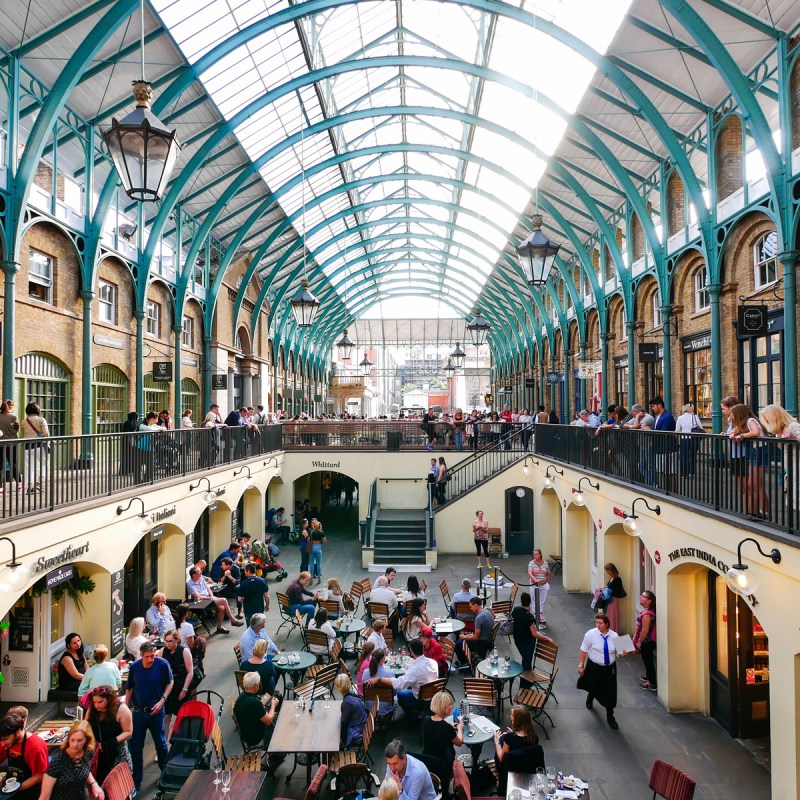
(Photo Credit: alice-photo / Shutterstock.com)
London is an eclectic city with so many sights and so much going on — from theater shows and nightlife to unique dining experiences.
Videos by TravelAwaits
Indeed, there are also some beautiful parks in London frequented by locals that are just waiting to be discovered. There is also some great street food markets in London, but visitors should make an effort to visit a plethora of these other kinds of markets in order to experience daily life in the British capital.

(Photo Credit: William Barton / Shutterstock.com)
1. Alfies Antique Market
If it’s antiques you’re into, then head to the district of Marylebone in the West End of London, famous for the Madame Tussauds waxwork museum. Founded over 40 years ago, here you’ll find one of the capital’s largest antiques arcade — Alfies Antique Market — laid out over four floors in a huge Egyptian Art Deco building and home to over 100 dealers selling antique furniture, retro clothing, and jewelry, among other unique memorabilia.
Come and browse, soak up the atmosphere, then head to the rooftop cafe for a spot of brunch and to bask in the sunlight. The building itself is considered a bohemian landmark amongst the London skyline, making it very Instagram-worthy.
- Open: Tuesday–Saturday, 11 a.m.–6 p.m.
- Address: 13–25 Church Street, London, NW8 8DT
- Underground: Edgware Road tube or Marylebone tube/rail

(Photo Credit: William Barton / Shutterstock)
2. Brixton Village And Market Row
These two indoor markets, located in South London, help lend a vibrancy to this culturally diverse area of the city. There’s a selection of food stalls, including Franco Manca pizzeria and Honest Burgers. Both originating in Brixton, they have since spread across the capital, exploring Caribbean, Portuguese, and French cuisine.
It’s not just the food that people come here for. You’ll find several independent outlets with a treasure trove of jewelry, clothes, art, and cute handmade gifts.
You’re guaranteed a glimpse into South London life, and will come away with a souvenir or two.
- Open: Daily, 8 a.m.–11:30 p.m.; Closes at 6 p.m. on Monday
- Address: Coldharbour Lane, Brixton, London, SW9 8PS
- Underground: Brixton

(Photo Credit: William Barton / Shutterstock.com)
3. Hackney Broadway Market
Broadway Market, a Victorian street in the North London borough of Hackney, has been trading in some form or another since 1000 BC. The Phoenicians used it as a trading route for any excess tin-mining from Cornwall.
In the 1890s, it was a traditional fruit and vegetable market. Nowadays on a Saturday, it turns into a hub of over 135 stalls for visitors to browse books, vintage clothes, delicatessen groceries, and freshly ground coffee, among other goodies.
But don’t just come on a Saturday. The street is lined with independent coffee shops and restaurants, barber shops, groceries, and independent retail stores all the way down to Regents Canal. A visit to this neighborhood is worth it any day of the week.
- Open: The actual market, Saturdays, 9 a.m.–5 p.m.
- Address: Broadway Market, London Fields, London, E8 4PH
- Underground: Bethnal Green
- Train: London Fields overground

(Photo Credit: IR Stone / Shutterstock.com)
4. Covent Garden Market
The neoclassical building that stands in the heart of Covent Garden Market is considered a landmark and was used to trade as a traditional fruit and vegetable market until the 1980s.
Now, there’s a beautiful pedestrianized zone with antique and collectable stalls on Mondays, and the rest of the week, artisans showcasing their handmade jewelry, soaps, and hand-painted T-shirts.
There are permanent shops with over 200 brand names including Jo Malone, Molton Brown, and Mulberry, among others.
It gets very busy during the day — a better, quieter time is early evening in the summer when you can sit with a spritzer in one of many bars.
- Open: Monday–Saturday, 10 a.m.–7 p.m.; Sun, 11 a.m.–6 p.m.
- Address: Covent Garden Piazza, London, WC2E 8RF
- Underground: Covent Garden or Charing Cross

(Photo Credit: ElenaChaykinaPhotography / Shutterstock.com)
5. Greenwich Market
The Royal Borough of Greenwich in the southeastern part of the city is famous for the longitudinal Greenwich Meridian Line, the Royal Observatory, and was designated a UNESCO World Heritage Site in 1997. It has a rich maritime history with the clipper ship, the Cutty Sark, on prominent display.
The 18th-century indoor Greenwich Market is another pull factor to visit this borough. As well as the ubiquitous clothes and jewelry, you’ll also find unique pieces of furniture. Tuesdays and Thursdays are good for antiques, and on the other days of the week, there are more arts and craft stalls.
Once you’ve had a good browse, choose from over 40 food stalls ranging from artisan deli dishes to African and Asian cuisine, sure to satisfy your appetite.
- Open: Daily, 10 a.m.–5:30 p.m.
- Address: 5b Greenwich Market, Greenwich, London, SE10 9HZ
- Underground: Docklands Light Rail – Cutty Sark

(Photo Credit: William Barton / Shutterstock.com)
6. Portobello Road Market
You can’t visit London without visiting Portobello Road Market in the famous Notting Hill area of the city. Aside from marketing itself as the world’s largest antiques market — with over 1,000 dealers — it’s also where the ‘90s movie Notting Hill with Julia Roberts and Hugh Grant was based, so there’s a possibility you’ll recognize sections of it.
Taking its name from Portobello Farm in the area many years ago, originally, the street was a country lane in the 18th and 19th centuries that connected Notting Hill in the south and Kensall Green in the north.
The market is several in one, initially a fruit and vegetable market. From the 1940s onwards, it also started to attract “rag and bone” men — old junk dealers — who would sell their wares from their carts.
Today’s Portabello Road now consists of antiques and three other distinct sections:
- Clothing/fashion – Westway area
- Household essentials – Westway to Talbot Road
- Fruit, vegetables, and other food – Talbot Road to Elgin Crescent
- Antiques – Elgin Crescent to Chepstow Villas
It became run down in the 1980s due to underdevelopment but nowadays, due to gentrification, it’s become the market to visit and the area to live, not to mention the annual Notting Hill Carnival to attend.
The below times and market specialities are indicative only and subject to change.
- Open: Fruit & Veg, Monday–Wednesday, 9 a.m.–6 p.m.; New Goods, Thursday, 9 a.m.–1 p.m.; Antiques, Friday, 9 a.m.–7 p.m.; and Fashion Stalls, Saturday, 9 a.m.–7 p.m.
- Address: Running almost the length of Notting Hill from north to south
- Underground: Ladbrooke Grove or Notting Hill
7. Islington Farmers’ Market
Moving on to farmers markets now, the Islington Farmers’ Market is the oldest of its kind in the city, established in 1999. Islington itself has the second oldest pub theater in the UK, the King’s Head Theatre Pub, and fans of the Harry Potter series will know that Harry Potter and The Order of the Phoenix features its headquarters at 12 Grimmauld Place — a fictitious street in the borough.
The market is colorful with seasonal fruit and vegetables such as asparagus and strawberries in May, rooting vegetables in January, and even turkeys in December.
Aside from the fruit and vegetables, you can find fresh pasta, cakes, and bread.
If you’re not intending to buy, don’t worry. Have a wander around and soak up the atmosphere instead.
- Open: Sundays, 10 a.m.–2 p.m.
- Address: Chapel Market (Penton St.), Islington, Greater London, N1 9PZ
- Underground: Angel, Farringdon, or Liverpool Street
8. Parliament Hill Farmers Market
Organic fruit and vegetables, free range dairy, organic meat products, and a range of hot food stalls await to tempt you in this unique location. This farmers market prides itself on “high quality basic staples” rather than those with a high sugar content.
But the main pull for the Parliament Hill Farmers Market is, as mentioned, its location. The market is part of Hampstead Heath, one of London’s most popular parks at 800 acres of woodland walks, swimming pools, pubs, and film locations, like the aforementioned Notting Hill. Parliament Hill offers superb views across to the skyscrapers of London, such as Canary Wharf contrasting with the old St. Paul’s Cathedral, all from one vista.
Come and enjoy a walk first before browsing the stalls with the locals.
- Open: Saturdays, 10 a.m.–2 p.m.
- Address: Entrance at William Ellis School, off Highgate Road, London, NW5 1RN
- Underground: Tufnell Park

(Photo Credit: Chrispictures / Shutterstock.com)
9. Billingsgate Fish Market
The last market on the tour of our favorites in London is more for trade, but also open to the public — one that shouldn’t be missed.
Originally a market for fish, corn, coal, iron, wine, salt, and pottery, it wasn’t until the 16th century that Billingsgate Fish Market dealt exclusively with the fish trade. An Act of Parliament was passed back then to allow the sale of all sorts of fish, except eels. These were only allowed to be sold by Dutch fishermen who had moored their boats along the Thames. This was to recognize their efforts and award the fishermen for their help in feeding the local population during the devastating Great Fire of London in 1666.

(Photo Credit: Tupungato / Shuttestock.com)
Fish was sold from stalls until the mid-19th century when the market gradually grew in size. After moving to several purpose-built locations, it can now be found covering a 13-acre self-contained area in the Docklands of East London — the UK’s largest inland fish market.
Visit any day of the week and you’ll find two large trading halls on the ground floor with 98 stands and 13 shops, as well as two cafes. The produce is a mix of frozen and fresh fish, most of which arrives in the very early hours of the morning.
- Open: Tuesday–Saturday, 4 a.m.–8:30 p.m.
- Address: Trafalgar Way, Poplar, London, E14 5ST
- Underground: Canary Wharf or Poplar on the Docklands Light Railway
I hope you’ve been inspired to visit these London Markets and will allow yourself a glimpse into local life during your trip to the UK capital.
For more unique London experiences, read up on these stories:
